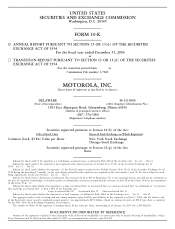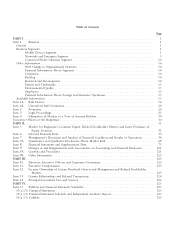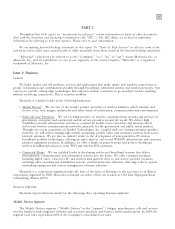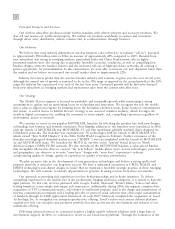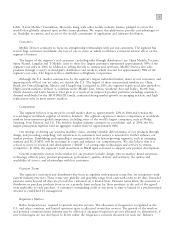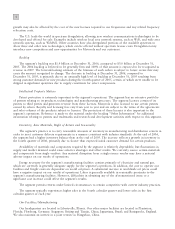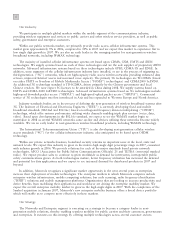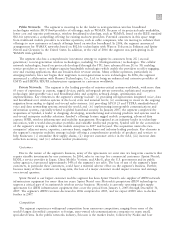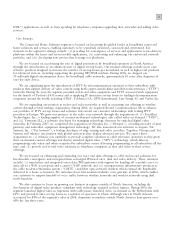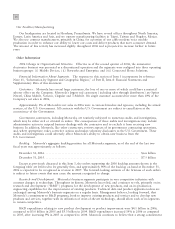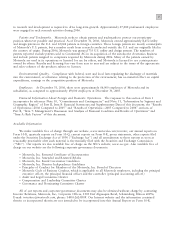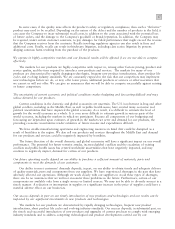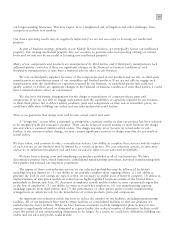Motorola 2006 Annual Report Download - page 17
Download and view the complete annual report
Please find page 17 of the 2006 Motorola annual report below. You can navigate through the pages in the report by either clicking on the pages listed below, or by using the keyword search tool below to find specific information within the annual report.
9
In early 2005, Sprint Nextel agreed to a plan by federal regulators designed to address interference from iDEN
phones with hundreds of public safety communications systems in the U.S. According to the FCC, the agreement
should dramatically reduce the likelihood of interference. Sprint Nextel is required to fund certain costs necessary
to relocate those impacted users onto alternate channels in the 800MHz spectrum. Motorola will continue to work
with our customers that are impacted by this plan and expects that this will have a neutral to positive impact on
the segment's business over the next several years. However, the short-term impact remains uncertain and is yet to
be quantified, as the plan is still being implemented throughout most of the country.
In February 2006, federal legislation was adopted setting February 17, 2009 as the date by which a portion of
the spectrum historically used for broadcast television must be cleared throughout the U.S. Segments of this
spectrum have been designated for public safety use and other segments for commercial operations, both market
segments in which Motorola participates. This spectrum was designated for public safety and commercial use in
1997, however, prior to this new legislation, there was no certainty as to when it actually would be cleared for use
in major markets. Clearing broadcast television from this band will significantly increase the spectrum public safety
and commercial entities have available for communications systems. The new spectrum is configured to support
both voice and data and the FCC has also opened additional rulemaking proceedings to help enable future
broadband operations for public safety. Motorola already has public safety infrastructure and mobiles/portables
shipping for deployment of voice and data systems in this band and we anticipate the availability of broadband
equipment in the future.
Backlog
The segment's backlog was $4.4 billion as of December 31, 2006, compared to $4.1 billion as of December 31,
2005. The 2006 order backlog is believed to be generally firm and approximately 85% of that amount is expected
to be recognized as revenue during 2007. The forward-looking estimate of the firmness of such orders is subject to
future events that may cause the amount recognized to change.
Intellectual Property Matters
Patent protection is extremely important to the segment's operations. The segment has an extensive portfolio
of patents relating to its products, systems, technologies and manufacturing processes.
The segment licenses some of its patents to third parties and generates modest revenue from these licenses.
Motorola is also licensed to use certain patents owned by others. Royalty and licensing fees vary from year to year
and are subject to the terms of the agreements and sales volumes of the products subject to licenses. Reference is
made to the material under the heading ""Other Information'' for information relating to patents and trademarks
and research and development activities with respect to this segment.
We actively participate in the development of open standards for interoperable, mission-critical digital two-way
radio systems. We have published our technology and licensed patents to signatories of the industry's two primary
memorandums of understanding defined by the Telecommunications Industry Association (""TIA'') Project 25 and
European Telecommunications Standards Institute (""ETSI'') Terrestrial Trunked Radio (""TETRA''). Royalties
associated with these licenses are not expected to be material to the segment's financial results.
Inventory, Raw Materials, Right of Return and Seasonality
The segment's practice is to carry reasonable amounts of inventory in order to meet customer delivery
requirements in a manner consistent with industry standards. At the end of 2006, the segment had a higher
inventory balance than at the end of 2005, primarily due to a larger amount of inventory to fulfill longer-term
projects.
Our private networks business provides custom products based on assembling basic units into a large variety of
models or combinations. This requires the stocking of inventories and large varieties of piece parts and replacement
parts, as well as a variety of basic level assemblies in order to meet delivery requirements. Relatively short delivery
requirements and historical trends determine the amounts of inventory to be stocked. To the extent suppliers'
product life cycles are shorter than the segment's, stocking of lifetime buy inventories is required. In addition,
replacement parts are stocked for delivery on customer demand within a short delivery cycle.


